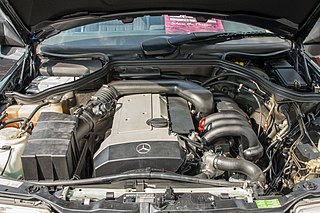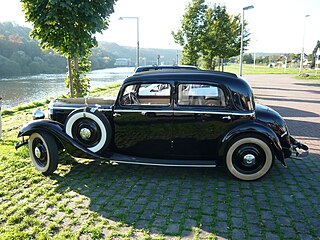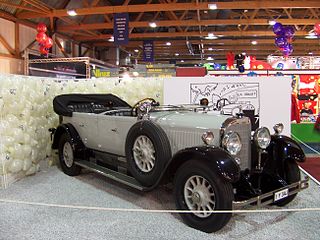Related Research Articles

The Mercedes-Benz M104 is a automobile straight-six engine produced from 1988 through 1999. It has a double overhead cam design with 4 valves per cylinder, and used a crossflow cylinder head. It replaced the M103 and was replaced by the M112 V6 starting in 1997. The bore spacing on all M104 engines is the same as M103 engines.

The Mercedes-Benz Mannheim 350 replaced the W03/Typ 350 models in 1929. The structure originated by Ferdinand Porsche was modified by Hans Nibel.

The Mercedes-Benz W 21 was a six-cylinder passenger car launched in 1933 using the name Mercedes-Benz Typ 200. It was one of several Mercedes-Benz models known, in its own time, as the Mercedes-Benz 200 and is therefore in retrospect more commonly referred to using its Mercedes-Benz works number, “W21”.

The Mercedes-Benz W 142 was a six-cylinder passenger car launched in February 1937, as a successor to the Mercedes-Benz Typ 290. The car was known by its name Typ 320 at the time of its production and service, but is in retrospect commonly referred to using its Mercedes-Benz works number, "W142", which gives a more unambiguous, unique nomenclature.

The Mercedes-Benz W18 was a six-cylinder automobile introduced as the Mercedes-Benz Typ 290 in 1933. It was a smaller-engined successor to the manufacturer’s Typ 350 / 370 Mannheim model. In terms of the German auto-business of the 1930s it occupied a market position roughly equivalent to that filled by the Mercedes-Benz E-Class in the closing decades of the twentieth century. The W18 was replaced in 1937 by the manufacturer’s W142.

The Mercedes 15/70/100 PS was a large automobile introduced by Daimler in 1924. Production continued till 1929 by which time Daimler had merged with Benz & Cie as a result of which the car's name had changed to Mercedes-Benz Typ 400.

The Mercedes 24/100/140 PS was a large luxury car introduced by Daimler of Untertürkheim in 1924. Production continued until 1929 by which time Daimler had merged with Benz & Cie and the car's name changed to Mercedes-Benz Typ 630. The car was conceptually and structurally similar to the contemporary Mercedes 15/70/100 PS, but the 24/100/140 PS was longer, heavier, more powerful, faster and more expensive.

The Mercedes-Benz W02 was a midsize six-cylinder two-litre-engined automobile introduced by Daimler-Benz at the Berlin Motor Show in October 1926. It was developed in some haste under the manufacturer's Technical Director, Ferdinand Porsche in parallel with the smaller Mercedes-Benz W 01 and the larger three-litre-engined Mercedes-Benz W03 following the creation of Daimler-Benz, formally in July 1926, from the fusion of the Daimler and Benz & Cie auto-businesses.

The Mercedes-Benz W03 was a large six-cylinder-engined automobile introduced as the Mercedes-Benz 12/55 PS and, initially, as the Mercedes-Benz Typ 300, by Daimler-Benz at the Berlin Motor Show in October 1926. It was developed in some haste under the manufacturer's Technical Director, Ferdinand Porsche in parallel with the smaller Mercedes-Benz W 01 and the two-litre-engined Mercedes-Benz W02 following the creation of Daimler-Benz, formally in July 1926, from the fusion of the Daimler and Benz & Cie auto-businesses.
The Mercedes-Benz M08 engine is a naturally-aspirated and supercharged, 4.6-liter and 5.0-liter, straight-8 engine, designed, developed and produced by Mercedes-Benz; between 1928 and 1940.
The Mercedes-Benz M23 engine is a naturally-aspirated, 1.3-liter, inline-4 gasoline engine, designed, developed and produced by Mercedes-Benz; between 1933 and 1936.
The Mercedes-Benz M21 engine is a naturally-aspirated, 2.0-liter, straight-6, internal combustion piston engine, designed, developed and produced by Mercedes-Benz; between 1933 and 1936.
The Mercedes-Benz M18 engine is a naturally-aspirated, 2.9-liter, straight-6, internal combustion piston engine, designed, developed and produced by Mercedes-Benz; between 1933 and 1937.
The Mercedes-Benz M15 engine is a naturally-aspirated, 1.7-liter, straight-6, internal combustion piston engine, designed, developed and produced by Mercedes-Benz; between 1931 and 1936.
The Mercedes-Benz M11 engine is a naturally-aspirated, 2.6-liter, straight-6, internal combustion piston engine, designed, developed and produced by Mercedes-Benz; between 1929 and 1935.
The Mercedes-Benz M06 engine is a supercharged, 6.8-liter to 7.1-liter, straight-6, internal combustion piston engine, designed, developed and produced by Mercedes-Benz; between 1928 and 1934.
The Mercedes-Benz M03 engine is a naturally-aspirated, 3.0-liter, straight-6, internal combustion piston engine, designed, developed and produced by Mercedes-Benz; between 1926 and 1927.
The Mercedes-Benz M02 engine is a naturally-aspirated, 2.0-liter, straight-6, internal combustion piston engine, designed, developed and produced by Mercedes-Benz; between 1926 and 1933.
The Daimler-Mercedes M9456 engine is a supercharged and naturally-aspirated, 6.2-liter to 6.4-liter, straight-6, internal combustion piston engine, designed, developed and produced by Mercedes-Benz, in partnership with Daimler; between 1924 and 1929.
The Daimler-Mercedes M836 engine is a naturally-aspirated and supercharged, 3.9-liter to 4.0-liter, straight-6, internal combustion piston engine, designed, developed and produced by Mercedes-Benz, in partnership with Daimler; between 1924 and 1929.
References
- ↑ "Mercedes-Benz M04 Engine". Sportlichleicht.com. Retrieved 10 November 2021.
- ↑ "Mercedes-Benz 12/55 PS Typ 300 Torpedo Manual, 55hp, 1927". Car.info. Retrieved 10 November 2021.
- ↑ "MERCEDES BENZ Typ S (W06) specs & photos - 1927, 1928". Autoevolution.com. Retrieved 10 November 2021.
- ↑ Murphy, William (2 July 2008). "1927 Mercedes-Benz S-Type Sportwagen". Simeone Foundation Automotive Museum. Retrieved 10 November 2021.
- ↑ "MERCEDES BENZ Typ 12/55 - 14/60 (W03/W04/W05) specs & photos - 1926, 1927, 1928, 1929". Autoevolution. Retrieved 10 November 2021.
- ↑ "Mercedes-Benz 12/55 PS Torpedo W04". Car.info. Retrieved 10 November 2021.